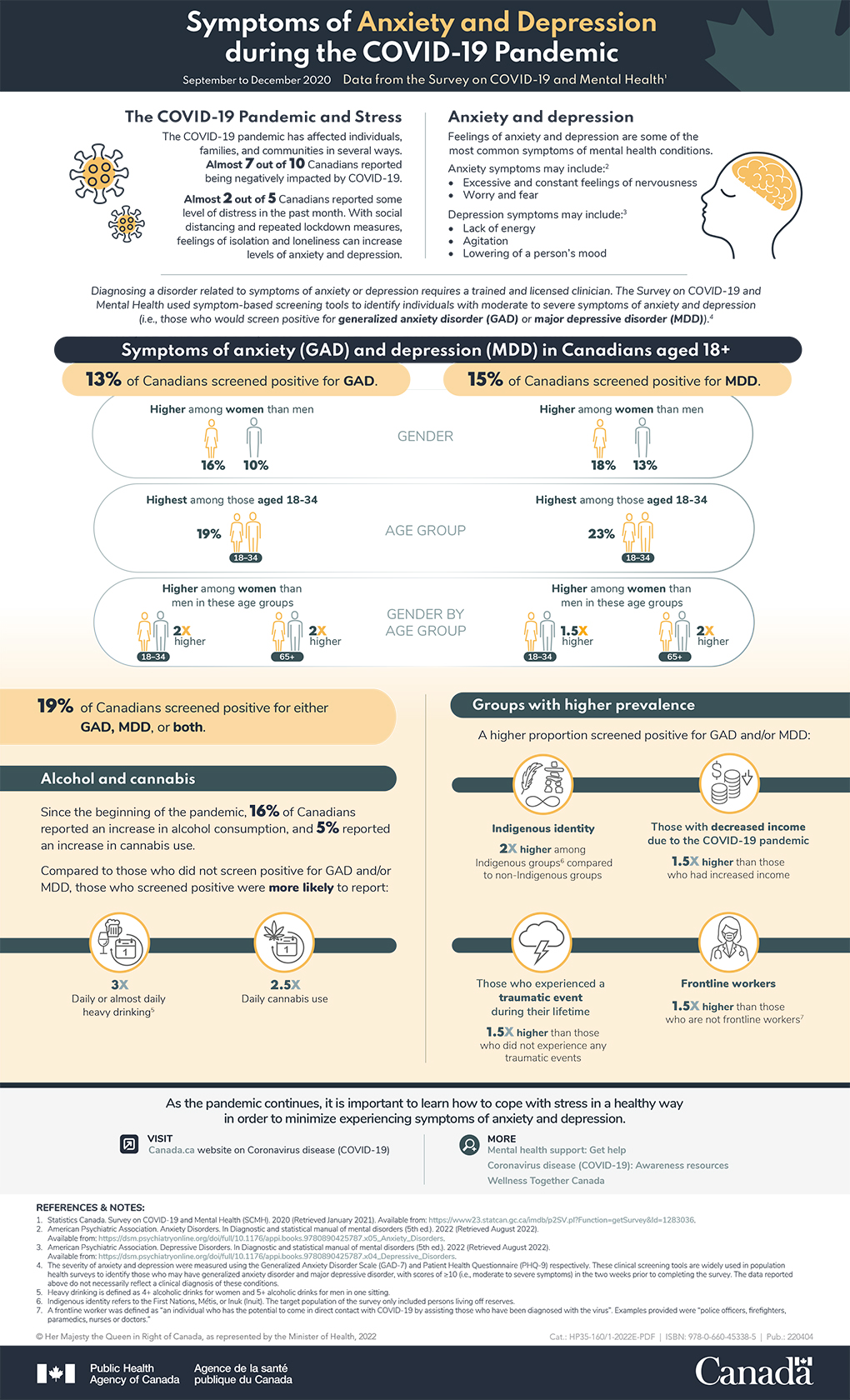Symptoms of anxiety and depression during the COVID-19 pandemic
Download in PDF format
(258 KB, 1 page)
Organization: Public Health Agency of Canada
Published: 2021-05-31
Tell us what you think
Help us improve our products. Answer our quick survey.
September to December 2020
Data from the Survey on COVID-19 and Mental HealthFootnote 1
The COVID-19 pandemic and stress
The COVID-19 pandemic has affected individuals, families, and communities in several ways. Almost 7 out of 10 Canadians reported being negatively impacted by COVID-19.
Almost 2 out of 5 Canadians reported some level of distress in the past month. With social distancing and repeated lockdown measures, feelings of isolation and loneliness can increase levels of anxiety and depression.
Anxiety and depression
Feelings of anxiety and depression are some of the most common symptoms of mental health conditions.
Anxiety symptoms may include:Footnote 2
- Excessive and constant feelings of nervousness
- Worry and fear
Depression symptoms may include:Footnote 3
- Lack of energy
- Agitation
- Lowering of a person’s mood
Diagnosing a disorder related to symptoms of anxiety or depression requires a trained and licensed clinician. The Survey on COVID-19 and Mental Health used symptom-based screening tools to identify individuals with moderate to severe symptoms of anxiety and depression (i.e., those who would screen positive for generalized anxiety disorder (GAD) or major depressive disorder (MDD)).Footnote 4
Symptoms of anxiety (GAD) and depression (MDD) in Canadians aged 18+
13% of Canadians screened positive for GAD. This was:
- Higher among women than men
- Women 16%
- Men 10%
- Highest among those aged 18-34 years 19%
- Higher among women than men in these age groups
- 2 times higher among the 18-34 age group
- 2 times higher among the 65+ age group
15% of Canadians screened positive for MDD. This was:
- Higher among women than men
- Women 18%
- Men 13%
- Highest among those aged 18-34 years 23%
- Higher among women than men in these age groups
- 1.5 times higher among the 18-34 age group
- 2 times higher among the 65+ age group
19% of Canadians screened positive for either GAD, MDD, or both.
Alcohol and cannabis
Since the beginning of the pandemic, 16% of Canadians reported an increase in alcohol consumption, and 5% reported an increase in cannabis use.
Compared to those who did not screen positive for GAD and/or MDD, those who screened positive were more likely to report:
- Daily or almost daily heavy drinkingFootnote 5 – 3 times more likely
- Daily cannabis use – 2.5 times more likely
Groups with higher prevalence
A higher proportion screened positive for GAD and/or MDD:
- Indigenous identity – 2 times higher among Indigenous groupsFootnote 6 compared to non-Indigenous groups
- Those with decreased income due to the COVID-19 pandemic – 1.5 times higher than those who had increased income
- Those who experienced a traumatic event during their lifetime – 1.5 times higher than those who did not experience any traumatic events
- Frontline workers – 1.5 times higher than those who are not frontline workersFootnote 7
As the pandemic continues, it is important to learn how to cope with stress in a healthy way in order to minimize experiencing the symptoms of anxiety and depression.
Visit: Canada.ca website on Coronavirus disease (COVID-19)
Like us: @HealthyCdns
Follow us: @GovCanHealth
Related links
- Cycle 2: Symptoms of anxiety and depression during the COVID-19 pandemic
- Mental health support: Get help
- Coronavirus disease (COVID-19): Awareness resources
- Wellness Together
References and notes:
- Footnote 1
-
Statistics Canada. Survey on COVID-19 and Mental Health (SCMH). 2020 (Retrieved January 2021). Available from: https://www23.statcan.gc.ca/imdb/p2SV.pl?Function=getSurvey&Id=1283036.
- Footnote 2
-
American Psychiatric Association. Anxiety Disorders. In Diagnostic and statistical manual of mental disorders (5th ed.). 2022 (Retrieved August 2022). Available from: https://dsm.psychiatryonline.org/doi/full/10.1176/appi.books.9780890425787.x05_Anxiety_Disorders.
- Footnote 3
-
American Psychiatric Association. Depressive Disorders. In Diagnostic and statistical manual of mental disorders (5th ed.). 2022 (Retrieved August 2022). Available from: https://dsm.psychiatryonline.org/doi/full/10.1176/appi.books.9780890425787.x04_Depressive_Disorders.
- Footnote 4
-
The severity of anxiety and depression were measured using the Generalized Anxiety Disorder Scale (GAD-7) and Patient Health Questionnaire (PHQ-9) respectively. These clinical screening tools are widely used in population health surveys to identify those who may have generalized anxiety disorder and major depressive disorder, with scores of ≥10 (i.e., moderate to severe symptoms) in the two weeks prior to completing the survey. The data reported above do not necessarily reflect a clinical diagnosis of these conditions.
- Footnote 5
-
Heavy drinking is defined as 4+ alcoholic drinks for women and 5+ alcoholic drinks for men in one sitting.
- Footnote 6
-
Indigenous identity refers to the First Nations, Métis, or Inuk (Inuit). The target population of the survey only included persons living off reserves.
- Footnote 7
-
A frontline worker was defined as “an individual who has the potential to come in direct contact with COVID-19 by assisting those who have been diagnosed with the virus”. Examples provided were “police officers, firefighters, paramedics, nurses or doctors.”
